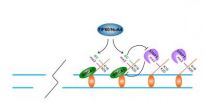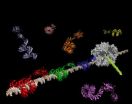(Press-News.org) February 4, 2013, New York, NY and Oxford, UK – Nearly every cell in the human body carries a copy of the full human genome. So how is it that the cells that detect light in the human eye are so different from those of, say, the beating heart or the spleen?
The answer, of course, is that each type of cell selectively expresses only a unique suite of genes, actively silencing those that are irrelevant to its function. Scientists have long known that one way in which such gene-silencing occurs is by the chemical modification of cytosine—one of the four bases of DNA that write the genetic code—to create an "epigenetic" marker known as 5-methylcytosine (5mC). Appropriate placement of this marker is essential to many normal biological processes, not least embryonic development. Conversely, its erroneous distribution contributes to the evolution of a broad range of cancers.
But 5mC is not the only epigenetic marker on the genomic block. About three years ago at Rockefeller University, Skirmantas Kriaucionis, currently a Ludwig researcher based at Oxford University, and Nathaniel Heintz, of Rockefeller University, discovered that a second modification of cytosine that converts it into 5-hydroxymethylcytosine (5hmC) seems to play a similarly vital role in the selective expression of the genome. Since then, researchers have scrambled to figure out what precisely that role might be. In a recent issue of the journal Cell, Heintz, Kriaucionis and colleagues report that the 5hmC marker has an effect on gene expression opposite to that of 5mC, and identify how its signal is detected and broadly interpreted in the healthy brain cells of mice. Since changes in the distribution of 5hmC are known to take place in a broad range of tumor cells, these findings could prove to be of great value to cancer research.
To begin, the team mapped where exactly 5hmC is found across the genomes of three types of healthy mouse neural cells. They discovered that it is largely associated with DNA that is loosely looped about its protein scaffolding in the nucleus. The 5mC signal, meanwhile, is predominantly located on more tightly packed, less accessible stretches of DNA. It is on the loosely packed DNA that most gene expression takes place.
In line with that finding, they discovered that the 5hmC marker was scattered over regions of the genome where genes are being expressed at high levels. And in concurrence with other studies, they found that the 5mC signal was mainly located on silent islands of the genome.
When the researchers peered more closely at the DNA sequence, they further discovered that 5hmC is largely planted within gene bodies—the parts of genes that encode proteins—not in intervening sequences that mark where the coding regions begin (promoters) and determine how avidly the genes are expressed (enhancers). This surprised them, as it is in such sequences that one would expect an on switch for a gene to be located. "It's easy to see how a modification of enhancer or promoter regions might affect gene expression," says Kriaucionis, PhD, and an assistant member of the Ludwig Institute at Oxford University.
"Indeed, we know 5hmC is found in those sequences in embryonic stem cells, which give rise to the whole body. But it is much less clear how the placement of this marker on the gene body—which contains the instructions for making a protein, not the sequences that determine when or how much of it is made—could have such a pronounced effect on gene activation."
Kriaucionis and colleagues in Nathaniel Heintz' team also discovered that in places where 5hmC is common, 5mC is found at low levels, and vice versa. Further, the patterns and ratios of the two markers and the genes highly expressed in each of the cells assessed varied dramatically. This implies that preexisting molecular signals that are unique to each kind of cell are vital to determining where exactly the 5hmC marker is placed across the genome. Changes in such signals are likely to play a role in the generation of disease, including cancers.
Next, the researchers sought to determine how the 5hmc signal is read. "We must understand what 5hmC is doing in normal cells," says Kriaucionis. "Understanding that will help us trace the process by which genes are incorrectly expressed in disease." The researchers discovered that a molecule known as methyl-CpG-binding protein (MeCP2), which binds 5mC, also binds 5hmC in the cells they studied. Mutations in this protein are known to contribute to Rett Syndrome, a developmental disorder that varies in severity depending on how precisely MeCP2 has been altered. Most importantly one of those mutant MeCP2 proteins was capable of binding 5mC, but not 5hmC. That mutant is known to cause relatively less severe cognitive and speech deficits in Rett patients.
Finally, investigators show in their paper that MeCP2 binding to 5hmC drives gene expression by making DNA more accessible to the molecular machinery that decodes genetic information—while its association with 5mC has the opposite effect. Though the current study focused on healthy mouse neural tissue, the unraveling of 5hmC's tangled role in genome expression is likely to be of value to cancer research. Other researchers have shown that 5hmC is highly depleted in several cancers, including the blood cancer acute myeloid leukemia and the blood disorder myelodysplastic syndrome, which can progress to cancer. This depletion is accompanied by the disruption of a tumor suppressor gene named TET2, which encodes a protein that creates the 5hmC signal on DNA.
Kriaucionis's lab is now assessing what role 5hmC plays in the development of different types of blood cells, with the aim of deciphering how its loss contributes to the generation of blood cancers.
###
This work was supported by the Howard Hughes Medical Institute (NH), Simons Foundation Autism Research Initiative and Conte Center PSH MH090963 (NH), the Ludwig Institute for Cancer Research (SK) and Spanish MECD (MM).
About The Ludwig Institute for Cancer Research
The Ludwig Institute for Cancer Research is an international non-profit organization committed to improving the understanding and control of cancer through integrated laboratory and clinical discovery. Leveraging its worldwide network of investigators and the ability to sponsor and conduct its own clinical trials, Ludwig is actively engaged in translating its discoveries into applications for patient benefit. Since its establishment in 1971, the Ludwig Institute has expended more than $1.5 billion on cancer research.
For further information please contact Rachel Steinhardt, rsteinhardt@licr.org or +1-212-450-1582.
A little tag with a large effect
Epigenetic marker 5hmC opens the door to studying its role in developmental disorders and disease
2013-02-04
ELSE PRESS RELEASES FROM THIS DATE:
Shop King Jewelers 2013 Valentine's Day Jewelry Sale for Savings on Unique Valentine's Gifts & Valentine's Day Presents for Men and Women
2013-02-04
Searching for the perfect Valentine's Day gift doesn't have to be a stressful experience. King Jewelers believes that the pursuit of a unique valentine's gift for the one you love can be an enjoyable and extremely personal experience, even online. That's why for this Valentine's Day King Jewelers has put together an exclusive selection of fine jewelry, watches, diamond studs, diamond pendants and accessories for men and women that will make ideal Valentine's Day gift ideas for your loved one.
Valentines Day Gift Ideas for Him and Her
Online shoppers will find a wide ...
DNA reveals mating patterns of critically endangered sea turtle
2013-02-04
New University of East Anglia research into the mating habits of a critically endangered sea turtle will help conservationists understand more about its mating patterns.
Research published today in Molecular Ecology shows that female hawksbill turtles mate at the beginning of the season and store sperm for up to 75 days to use when laying multiple nests on the beach.
It also reveals that these turtles are mainly monogamous and don't tend to re-mate during the season.
Because the turtles live underwater, and often far out to sea, little has been understood about their ...
Changes to DNA on-off switches affect cells' ability to repair breaks, respond to chemotherapy
2013-02-04
PHILADELPHIA - Double-strand breaks in DNA happen every time a cell divides and replicates. Depending on the type of cell, that can be pretty often. Many proteins are involved in everyday DNA repair, but if they are mutated, the repair system breaks down and cancer can occur. Cells have two complicated ways to repair these breaks, which can affect the stability of the entire genome.
Roger A. Greenberg, M.D., Ph.D., associate investigator, Abramson Family Cancer Research Institute and associate professor of Cancer Biology at the Perelman School of Medicine, University of ...
Researchers discover mutations linked to relapse of childhood leukemia
2013-02-04
After an intensive three-year hunt through the genome, medical researchers have pinpointed mutations that leads to drug resistance and relapse in the most common type of childhood cancer—the first time anyone has linked the disease's reemergence to specific genetic anomalies.
The discovery, co-lead by William L. Carroll, MD, director of NYU Langone Medical Center's Cancer Institute, is reported in a study published online February 3, 2013, in Nature Genetics.
"There has been no progress in curing children who relapse, in spite of giving them very high doses of chemotherapy ...
Pioneering research helps to unravel the brain's vision secrets
2013-02-04
A new study led by scientists at the Universities of York and Bradford has identified the two areas of the brain responsible for our perception of orientation and shape.
Using sophisticated imaging equipment at York Neuroimaging Centre (YNiC), the research found that the two neighbouring areas of the cortex -- each about the size of a 5p coin and known as human visual field maps -- process the different types of visual information independently.
The scientists, from the Department of Psychology at York and the Bradford School of Optometry & Vision Science established ...
Immune cell 'survival' gene key to better myeloma treatments
2013-02-04
Scientists have identified the gene essential for survival of antibody-producing cells, a finding that could lead to better treatments for diseases where these cells are out of control, such as myeloma and chronic immune disorders.
The discovery that a gene called Mcl-1 is critical for keeping this vital immune cell population alive was made by researchers at Melbourne's Walter and Eliza Hall Institute. Associate Professor David Tarlinton, Dr Victor Peperzak and Dr Ingela Vikstrom from the institute's Immunology division led the research, which was published today in ...
Growth factor aids stem cell regeneration after radiation damage
2013-02-04
DURHAM, N.C. – Epidermal growth factor has been found to speed the recovery of blood-making stem cells after exposure to radiation, according to Duke Medicine researchers. The finding could open new options for treating cancer patients and victims of dirty bombs or nuclear disasters.
Reported in the Feb. 3, 2013, issue of the journal Nature Medicine, the researchers explored what had first appeared to be an anomaly among certain genetically modified mice with an abundance of epidermal growth factor in their bone marrow. The mice were protected from radiation damage, and ...
Recreating natural complex gene regulation
2013-02-04
DURHAM, N.C. – By reproducing in the laboratory the complex interactions that cause human genes to turn on inside cells, Duke University bioengineers have created a system they believe can benefit gene therapy research and the burgeoning field of synthetic biology.
This new approach should help basic scientists as they tease out the effects of "turning on" or "turning off" many different genes, as well as clinicians seeking to develop new gene-based therapies for human disease.
"We know that human genes are not just turned on or off, but can be activated to any level ...
Plant scientists at CSHL demonstrate new means of boosting maize yields
2013-02-04
Cold Spring Harbor, NY – A team of plant geneticists at Cold Spring Harbor Laboratory (CSHL) has successfully demonstrated what it describes as a "simple hypothesis" for making significant increases in yields for the maize plant.
Called corn by most people in North America, modern variants of the Zea mays plant are among the indispensable food crops that feed billions of the planet's people. As global population soars beyond 6 billion and heads for an estimated 8 to 9 billion by mid-century, efforts to boost yields of essential food crops takes on ever greater potential ...
Poor mental health leads to unhealthy behaviors among low-income adults
2013-02-04
Poor mental health leads to unhealthy behaviors in low-income adults – not the other way around, according to a new study¹ by Dr. Jennifer Walsh and colleagues from the Centers for Behavioral and Preventive Medicine at The Miriam Hospital in the US. In this study, stress and anxiety predicted subsequent health-compromising behaviors, such as smoking, binge drinking, illegal drug use, unprotected sex and unhealthy diets. One possible explanation for these findings is that health compromising behaviors may be used as coping mechanisms to manage the effects of stress and anxiety. ...
LAST 30 PRESS RELEASES:
Jeonbuk National University study shows positive parenting can protect adolescents against self-harm
Surface-engineered ZnO nanocrystals to tackle perfluoroalkyl substance contamination
This new understanding of T cell receptors may improve cancer immunotherapies
A new fossil face sheds light on early migrations of ancient human ancestor
A new immunotherapy approach could work for many types of cancer
A new way to diagnose deadly lung infections and save lives
40 percent of MRI signals do not correspond to actual brain activity
How brain-inspired algorithms could drive down AI energy costs
Gum disease may be linked to plaque buildup in arteries, higher risk of major CVD events
Contrails are a major driver of aviation’s climate impact
Structure of dopamine-releasing neurons relates to the type of circuits they form for smell-processing
Reducing social isolation protects the brain in later life
Keeping the heart healthy increases longevity even after cancer
Young adults commonly mix cannabis with nicotine and tobacco
Comprehensive review illuminates tau protein's dual nature in brain health, disease, and emerging psychiatric connections
Book prepares K-12 leaders for the next public health crisis
Storms in the Southern Ocean mitigates global warming
Seals on the move: Research reveals key data for offshore development and international ecology
Sports injuries sustained during your period might be more severe
World's first successful 2 Tbit/s free-space optical communication using small optical terminals mountable on satellites and HAPS
Can intimate relationships affect your heart? New study says ‘yes’
Scalable and healable gradient textiles for multi‑scenario radiative cooling via bicomponent blow spinning
Research shows informed traders never let a good climate crisis go to waste
Intelligent XGBoost framework enhances asphalt pavement skid resistance assessment
Dual-function biomaterials for postoperative osteosarcoma: Tumor suppression and bone regeneration
New framework reveals where transport emissions concentrate in Singapore
NTP-enhanced lattice oxygen activation in Ce-Co catalysts for low-temperature soot combustion
Synergistic interface engineering in Cu-Zn-Ce catalysts for efficient CO2 hydrogenation to methanol
COVID-19 leaves a lasting mark on the human brain
Scientists use ultrasound to soften and treat cancer tumors without damaging healthy tissue
[Press-News.org] A little tag with a large effectEpigenetic marker 5hmC opens the door to studying its role in developmental disorders and disease


